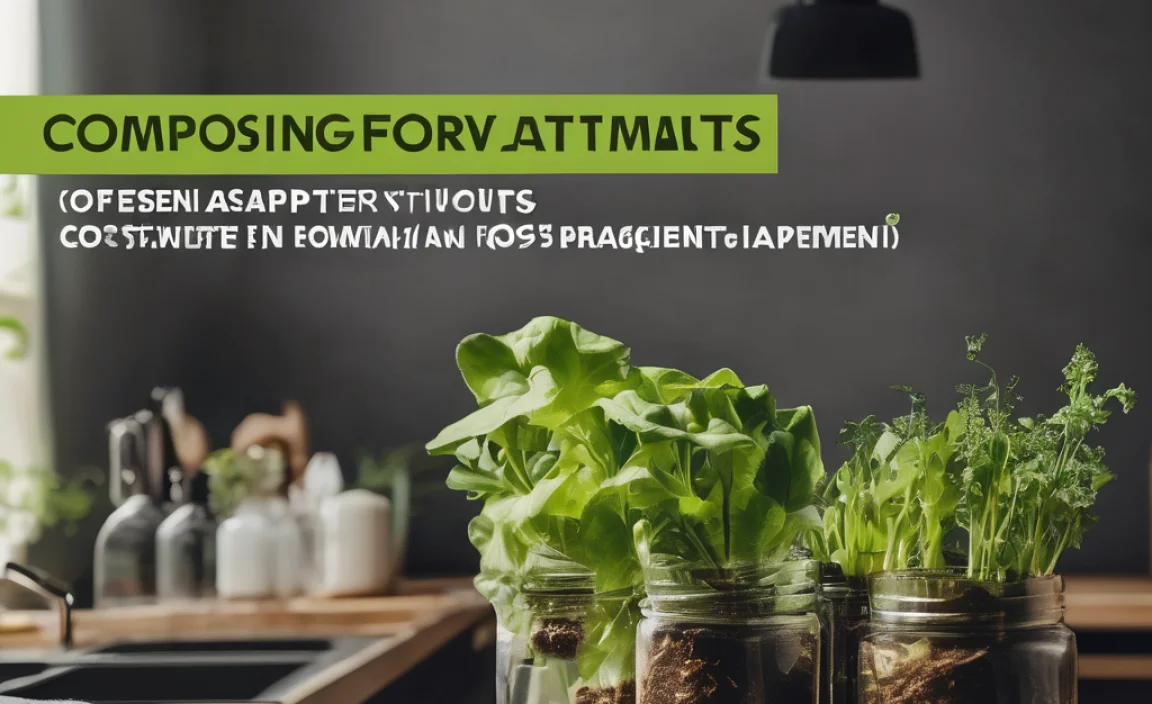Hey there! If you’re living that rural life and looking to turn your kitchen scraps and yard waste into something truly amazing for your garden, you’ve come to the right place. Composting can sound a bit tricky at first, especially when you’re just starting out. But don’t you worry, it’s actually simpler than you think! We’re going to walk through it, step-by-step, making sure you get a real handle on how to create that black gold your plants will love. Ready to get your hands a little dirty (in the best way possible)? Let’s dive in and make composting easy!
Composting for Beginners in Rural Areas: Your Essential Guide
Living out in the country has its perks, and one of them is having the space to compost! Instead of sending your food scraps and yard trimmings to the landfill, you can transform them into a nutrient-rich soil amendment. This “black gold” is fantastic for your garden, helping your plants grow bigger, healthier, and more vibrant. It’s also a wonderful way to reduce waste and contribute to a healthier environment. If you’re new to composting, this guide is going to make it super simple to get started, no matter your setup.
Why Compost? The Big Benefits
Composting isn’t just about getting rid of waste; it’s about creating something valuable. Here’s why it’s such a great idea, especially for those of us with a bit more room:
- Enriches Soil: Compost adds essential nutrients to your soil, improving its structure and water retention. This means healthier plants and less need for chemical fertilizers.
- Reduces Waste: A significant portion of household waste is compostable. Composting diverts this from landfills, reducing methane gas emissions.
- Saves Money: You’ll buy less fertilizer and soil amendments for your garden. Plus, it helps your soil retain water, potentially lowering your water bills.
- Environmentally Friendly: It’s a natural recycling process that supports a circular economy and reduces your carbon footprint.
- Great Exercise: Turning your compost pile can be a good way to get some fresh air and physical activity!
Getting Started: What You’ll Need
The beauty of composting is its flexibility. You don’t need fancy equipment. Here are the basics:
Choosing Your Composting System
Your location and how much material you’ll be composting will influence your choice. For rural beginners, these are the most practical options:
- Open Pile: This is the simplest method. You just create a heap of compostable materials in a designated spot. It’s great if you have plenty of space and don’t mind a less tidy look. You’ll need a corner of your yard that’s out of the way.
- Enclosed Bin (DIY or Purchased): These bins contain your compost, keeping it neater and often helping it break down faster. You can buy them at garden centers, or build one yourself from wood pallets, chicken wire, or plastic containers. This is excellent for keeping things tidy and deterring pests.
- Tumbler: These are rotating barrels. They make turning the compost easy and speed up the decomposition process. They can be a bit more of an investment, but they’re efficient and neat.
Essential Tools (Optional but Helpful)
While you can get by with just a pitchfork, a few tools can make the job easier:
- Pitchfork or Garden Fork: For turning and aerating your compost.
- Shovel: For moving materials into and out of the pile.
- Watering Can or Hose with Spray Nozzle: To keep your compost moist.
- Gloves: To keep your hands clean.
- Optional: A compost thermometer can help you monitor the temperature of your pile for faster decomposition.
The Recipe for Great Compost: Greens and Browns
Composting relies on a balance of two main types of materials: “greens” and “browns.” Getting this balance right is the key to a successful compost pile.
“Greens” (Nitrogen-Rich Materials)
These materials are moist and tend to break down quickly. They provide nitrogen, which is essential for the microorganisms that do the decomposing.
- Fruit and vegetable scraps (peels, cores, rinds)
- Coffee grounds and tea bags
- Grass clippings (in thin layers to avoid matting)
- Plant trimmings from the garden
- Manure from herbivores (cow, horse, chicken, rabbit – avoid pet waste)
“Browns” (Carbon-Rich Materials)
These materials are dry and provide carbon. They help with aeration and prevent the pile from becoming too wet and smelly. Think of them as the structure of your compost.
- Dry leaves
- Shredded newspaper (avoid glossy paper)
- Cardboard (torn or shredded, remove tape and labels)
- Straw and hay
- Wood chips or sawdust (in moderation)
- Small twigs and branches
What NOT to Compost
It’s just as important to know what to leave out of your compost bin to avoid problems:
- Meat, fish, and dairy products (attract pests and can smell)
- Oily or greasy foods
- Diseased plants or weeds that have gone to seed
- Pet waste (dog or cat feces can contain pathogens)
- Treated wood or sawdust from treated wood
- Coal or charcoal ash
- Glossy or colored paper/magazines
Building Your Compost Pile: A Simple Step-by-Step Guide
Ready to start? It’s easier than you think!
- Choose a Location:Find a spot that’s convenient for you, has good drainage, and gets a bit of sun (but not too much direct sun in very hot climates). It should also be accessible for adding materials and turning. If you’re in a rural setting, a corner of your yard or a dedicated spot works perfectly. Ensure it’s at least a few feet from any fences or structures you don’t want moisture near.
- Start with a Base Layer (Browns):Begin by laying down a layer of coarse brown materials at the bottom, about 4-6 inches thick. This could be twigs, straw, or shredded cardboard. This helps with airflow from the start.
- Add Greens and Browns in Layers:Now, start adding your materials. Aim for a ratio of roughly 2 parts browns to 1 part greens. It doesn’t have to be exact, but this is a good starting point. For example, add a layer of kitchen scraps (greens), then cover it with a layer of dry leaves or shredded newspaper (browns). Continue layering as you generate materials.
Tip: Chop or shred larger items into smaller pieces. This increases the surface area and helps them break down faster.
- Moisten as You Go:Compost needs moisture to work. It should feel like a wrung-out sponge – damp but not soaking wet. Water each layer as you add it, especially the brown materials. If your pile seems too dry, add more water. If it gets too wet (and starts to smell), add more brown materials.
- Aerate Your Pile:This is where turning comes in. Turning your compost pile introduces oxygen, which beneficial microbes need to thrive. It also helps to mix materials and speed up decomposition. Aim to turn it every 1-4 weeks. You can do this by forking the outer layers into the center and vice versa.
For Tumblers: Simply rotate the drum a few times every few days.
For Open Piles: Use a pitchfork to mix the materials.
- Wait and Watch:Composting takes time. Depending on the materials, the ratio, how often you turn it, and the temperature, it can take anywhere from a few months to a year. You’ll know it’s ready when it looks dark, crumbly, and smells earthy – like forest soil.
Troubleshooting Common Composting Problems
Even with the best intentions, sometimes things don’t go perfectly. Here are a few common issues and how to fix them:
Problem: Foul Odors (Ammonia or Rotten Egg Smell)
Cause: Too much nitrogen (too many greens) or not enough air. The pile is likely becoming anaerobic, which is a smelly process.
Solution: Add more brown materials (leaves, shredded cardboard, straw) to balance the nitrogen and improve airflow. Turn the pile thoroughly to aerate it.
Problem: Pile Isn’t Heating Up or Decomposing
Cause: Lack of moisture, too many brown materials, or not enough nitrogen. The microbes need the right conditions to work.
Solution: Moisten the pile if it’s dry. Add more green materials (kitchen scraps, grass clippings) to introduce nitrogen. Turn the pile to mix everything and encourage microbial activity.
Problem: Pests (Flies, Rodents, etc.)
Cause: Often attracted by exposed food scraps, meat, dairy, or greasy items.
Solution: Make sure you’re not adding prohibited items. Bury food scraps deep within the pile, always covering them with a layer of brown material. For rodent problems, consider a more secure compost bin or tumbler. A well-managed, hot compost pile is less attractive to pests.
Problem: Materials are Too Wet and Slimy
Cause: Too much moisture, often from excessive kitchen scraps or rain getting into an open pile.
Solution: Add plenty of dry brown materials (shredded newspaper, dry leaves, straw) to absorb excess moisture. Turn the pile to help it dry out and improve aeration.
Tips for Rural Composting Success
Being in a rural setting gives you some advantages! Here are a few insider tips:
- Utilize Yard Waste: You likely have more access to leaves, grass clippings, and small branches than your city-dwelling friends. Accumulate piles of leaves in the fall to have plenty of brown material throughout the year.
- Consider Manure: If you have livestock or access to manure from local farms (ensure it’s from herbivores and well-aged if possible), it’s a nitrogen powerhouse for your compost.
- Size Matters: For faster decomposition, aim for a compost pile that’s at least 3 feet by 3 feet by 3 feet. Larger masses tend to retain heat better, which is crucial for breaking down materials efficiently.
- Barn/Shed Sweepings: Old hay, straw, and even fine particles from the floor of a barn can be excellent brown material.
- Compost Your Weeds (Carefully): If you have weeds that haven’t gone to seed, they can be composted. However, if they have, it’s often best to hot compost them to kill any seeds, or avoid composting them altogether if your system isn’t robust enough.
When is Compost Ready?
Patience is key here! Your compost is ready when it meets these criteria:
- Appearance: It should be dark brown to black, crumbly, and no longer look like the original materials you put in.
- Smell: A finished compost pile should smell earthy and pleasant, like a forest floor after rain. Any foul odors mean it’s not ready.
- Temperature: It will have cooled down to ambient temperature. Hot composting kills weed seeds and pathogens, but the final product is cool.
Once ready, you can sift it to remove any larger, undecomposed bits (which can go back into the new pile) and then spread it on your garden beds. You’ll notice a significant improvement in your soil and plant health!
Using Your Finished Compost
The reward for your efforts is a fantastic soil enhancer. Here’s how you can use it:
- As a Soil Amendment: Mix a few inches of compost into your garden beds before planting. This improves soil structure, drainage, and fertility.
- As a Top Dressing: Once plants are growing, spread a layer of compost around their base. This suppresses weeds, retains moisture, and provides a slow release of nutrients.
- In Potting Mixes: Mix finished compost with other ingredients like perlite or coco coir to create a rich potting mix for containers.
- For Lawns: Loosen compacted soil by raking a thin layer of compost over it, especially after aerating.</li
- Around Trees and Shrubs: Apply a layer of compost around the base of trees and shrubs, extending to the drip line.
A Note on “Hot” vs. “Cold” Composting
You might hear about “hot” and “cold” composting. It’s good to understand the difference, even if you’re a beginner.
Hot Composting: This method aims to get the compost pile hot (130-160°F or 55-70°C). This requires a good balance of greens and browns, regular turning, and sufficient moisture. The heat generated kills weed seeds and pathogens, resulting in faster compost (often 1-3 months). It requires more active management.
Cold Composting: This is more of a “throw it and forget it” method. You pile materials and let nature take its course. It’s much slower (6-12+ months) and doesn’t get hot enough to kill weed seeds or pathogens reliably. It’s simpler but yields compost more slowly and may contain viable weed seeds.
For beginners, a slightly more active “warm” composting approach, aiming for a regular balance and occasional turning, is usually the sweet spot. It’s less demanding than hot composting but faster and more effective than cold composting.
Maintaining Your Compost System
Once your compost is established, ongoing maintenance is straightforward:
- Continue Adding Materials: Keep adding your kitchen scraps and yard waste, remembering to balance greens and browns and cover food scraps.
- Turn Periodically: Even if you’re not aiming for hot compost, turning your pile every few weeks will speed up decomposition and prevent it from becoming anaerobic.
- Monitor Moisture: Check the moisture level regularly. Add water if it’s dry, or add browns if it’s too wet.
- Be Patient: Some materials take longer to break down than others. That’s perfectly normal!
| Composting Element | Purpose | Examples | Ratio (Approx.) |
|---|---|---|---|
| Greens (Nitrogen) | Activates decomposition, provides heat | Fruit/veg scraps, grass clippings, coffee grounds, manure | 1 part |
| Browns (Carbon) | Provides bulk, air, prevents smels | Dry leaves, straw, shredded paper/cardboard, twigs | 2 parts |
| Water | Keeps microbes active | Rainwater, tap water | Damp like a wrung-out sponge |
| Air (Oxygen) | Essential for aerobic decomposition | Achieved by turning, layering coarse materials | Constant supply |
The Environmental Impact of Composting
Beyond your garden, composting has a ripple effect on the environment. By diverting organic waste from landfills, you help reduce the production of methane, a potent greenhouse gas. The U.S. Environmental Protection Agency (EPA) estimates that food waste alone accounts for a significant portion of municipal solid waste. Choosing to compost means you’re actively participating in a solution to waste management and climate change. For those in rural areas, reducing waste transport also means fewer trucks on the road, further cutting down on emissions. It’s a local action with global benefits!
Want to learn more about the science behind composting and its environmental benefits? Check out resources from the EPA’s Composting page for an in-depth look at how this natural process helps our planet.
Conclusion
And there you have it! Composting for beginners in rural areas doesn’t need to be complicated. By understanding the balance of greens and browns, keeping your pile moist but not soggy, and giving it a little air now and then, you’re well on your way to creating your own nutrient-rich compost. Remember, it’s a natural process, and patience is part of the journey. Don’t get discouraged if your first batch isn’t perfect; every pile teaches you something new. Embrace the process, reduce your waste, and get ready to see your garden flourish like never before!
FAQ: Your Composting Questions Answered
Q2: How do I know if my compost is too wet or too dry?
A2: It should feel like a wrung-out sponge – damp, not soggy. If you squeeze a handful and water drips out, it’s too wet. If it crumbles apart dry, it’s too dry.
Q3: Do I need a special bin for composting?
A3: Not necessarily! An open pile works, especially with plenty of space. Enclosed bins or tumblers help keep things neater and can speed up the process.
Q4: How often should I turn my compost pile?
A4: For faster results, turn it every 1-4 weeks. If you’re patient, turning less often (every few months) still works, it will just take longer.
Q5: My compost is taking forever to break down. What’s wrong?
A5: It might be too dry, lack nitrogen (greens), or not have enough air. Try adding water, some kitchen scraps, and turning the pile thoroughly.
Q6: Can I compost grass clippings?
A6: Yes! Grass clippings are a great source of nitrogen (greens). However, add them in thin layers to prevent matting, which can block airflow and cause odors. Mix them with brown materials.
Q7: What are the benefits of turning compost more often?
A7: Turning introduces oxygen, which speeds up the decomposition process. It also helps mix materials, ensuring everything composts evenly and efficiently, leading to quicker “black gold.”

I am passionate about home engineering. I specialize in designing, installing, and maintaining heating, ventilation, and air conditioning systems. My goal is to help people stay comfortable in their homes all year long.



